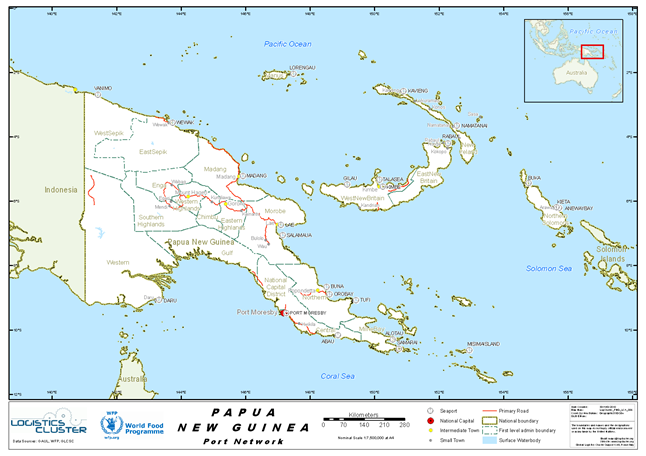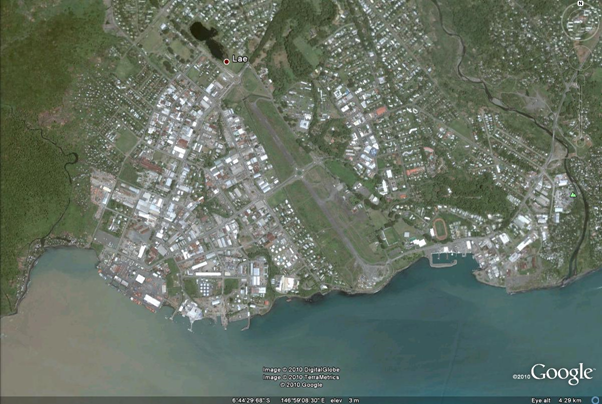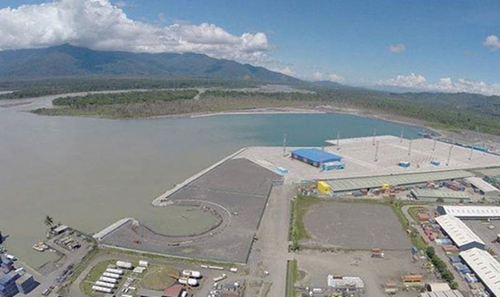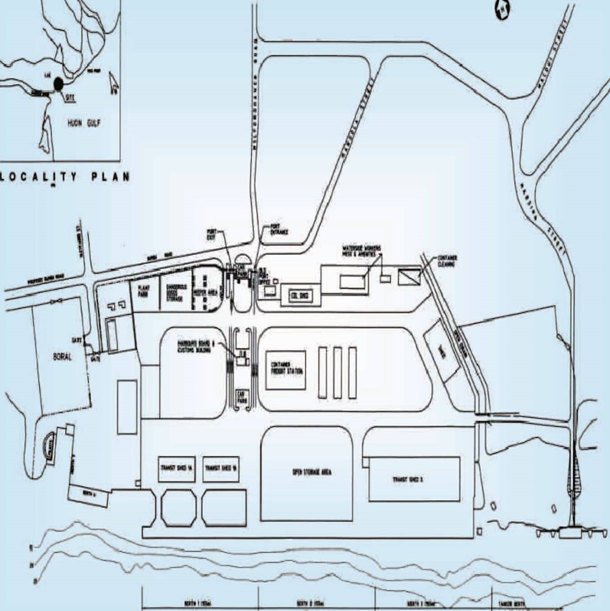2.1 Papua New Guinea Port Assessment
Introduction
Approximately 60% of the Papua New Guinea population resides on coasts, rivers, and swamps suitable for water navigation. The state-owned enterprise, PNG Ports Corporation Limited (PNGPCL), operates 16 large ports, 14 of which support both foreign and coastal shipping. Lae is the largest port, followed by Port Moresby. PNGPCL provides services on a commercial basis, but only two or three of the largest ports recover operating costs. Mining, construction, shipping and other private companies operate 11 or more additional ports. There may be as many as 400 additional community-owned and operated piers, jetties and landings supporting small craft use in remote communities.
PNGPCL insists on the confidentiality of its port traffic indicators.
PNG’s primary port, Lae, suffers from insufficient wharf space, limited storage capacity, and the absence of large-scale container handling equipment, while the country’s many loss-making ports have excess capacity. PNGPCL has expanded and improved Lae’s wharves and ADB is funding further expansion of the port to include a tidal basin providing sufficient capacity from 2018.
Coastal shipping services are comprehensive, employing almost 250 vessels, some of which are containerized. These ships operate between the 17 ports along the coastline of the mainland and the islands. International shipping lines operate regular freight services to and from South East Asia, Japan, Europe, New Zealand, the South Pacific and Australia.
In terms of operations management, equipment, infrastructures and operating companies,
- 6 out of 16 ports are able to host significant (as for the country) emergency operations: Buka, Kieta, Lae, Madang, Port Moresby and Rabaul
- The remaining 10 have sufficient infrastructures to act as intermediate operational hubs: Aitape, Alotau, Daru, Kavieng, Kimbe, Lorengau, Oro Bay, Samarai, Wewak, and Vanimo. Nevertheless, as their equipment is good but basic (forklifts, trailers) and in limited quantities, special attention should be paid before operating emergency activities in those ports
From a general point of view, Lae is the biggest port of the country in terms of volume of operations. It is also the one that has the best internal organization (Port Moresby port facilities being often congested), mainly relying on international operators with strong capacities. This is due to the already effective LNG projects ongoing on the Northern part of the Papuan Island.
Analysis of the Port Sector
Overview
The port sector of Papua New Guinea comprises 22 declared ports and many small wharves, jetties, and landing stages. Only the ports of Lae, Moresby, Madang, Kimbe, and Rabaul have appropriate port infrastructure and receive international as well as coastal traffic. Private organizations also establish and operate port facilities where government ports do not exist or where there are greater benefits. This is particularly the case for forestry, petroleum, mining companies, and some agricultural firms
The fully state-owned PNG Ports Corporation Limited (PNGPCL) operates 16 of the 22 declared ports, including two ports operated by its agents. The other six declared ports are either being run by private entities or not operating.
The PNGPCL-operated ports handle about 90% of international ships calling at PNG ports and 80% of PNG’s international and domestic cargo. The ports of Lae and Port Moresby alone account for more than 70% of the throughput of the declared ports.
Cargo Throughput
About 90% of vessel calls and more than 80% of PNG’s international and domestic cargo are handled at PNGPCL-operated ports. The increase in cargo handled since 2002 is noticeable. The ports of Lae and Port Moresby account for over 70% of the total throughput. Kimbe represents 8%, and Rabaul 6%.
Performance Indicators and Analysis
The port sector is particularly critical for a country like PNG, a Pacific island country whose territory comprises the eastern half of New Guinea and 600 offshore islands. Of its 20 provinces, 15 are on the coast. More than 60% of the country’s 6 million people are widely dispersed across islands and coral atolls and along the banks of major rivers. There is no national rail or road network. Although 46 airports and numerous airstrips serve a network of scheduled, charter, and missionary air services, even to some very remote communities, air transport is too costly for any trips other than emergencies.
Coastal trade, particularly outbound container cargo from Lae to other PNG ports, has been growing rapidly since 2001. Full outbound containers that year numbered 13,395 twenty-foot equivalent units (TEU); by 2005 they totaled 23,811 TEU, for an increase of 78%.
In sum, the port sector has a crucial role in the social and economic development of PNG. It is important not only for the adequate and efficient handling of exports and imports, but also for the efficient movement of goods and persons between the remote and sparsely populated areas on the mainland and islands and the centers of economic activity.
2.1.1 Papua New Guinea Port of Lae
Port Overview
The increase in vessel size and carrying capacity and the growing trend toward containerization have had significant impact on all PNG ports, particularly Lae port, PNG’s largest, busiest, and single most important port. Lae port handles about half of the throughput of the 22 declared ports and more than 60% of the international and coastal trade registered in PNGPCL’s ports, and generates more than 50% of PNGPCL’s revenue. It serves as a gateway linking the world market with a large hinterland comprising Morobe province, the city of Lae (the capital of the province, and PNG’s industrial and commercial center), and five resource-rich provinces in the Highlands. The hinterland is home to about half of the population and represents half of the territory. PNG’s most significant road, the Highlands Highway, runs from Lae to the Highlands region, dispensing imports ranging from heavy machinery to food products in the region and bringing the country’s major export items to Lae port. About 50% of PNG exports and 90% of coffee exports are shipped from Lae port.
Lae port has been adapting to the demands of container operations over the past 20 years. But investment in facility maintenance and expansion has not kept pace with the growing trend toward containerization and larger ships. The current five berths at Lae, with a total length of about 520 m, and a total storage area of 53,620 square meters (m2) for cargo marshaling, are aging and cannot handle increasing cargo volumes and ship sizes. Berth 4 for domestic ships can no longer accommodate these ships and is underused. Berth 1, with a total length of 123 m and water depth of 11 m, is suitable for overseas vessels but is now used as a domestic terminal. Overseas vessels are mainly served by berths 2 and 3, which have a total length of 307 m. As a result, port congestion at Lae is frequent, imposing high costs on port users. In 2005, all classes of vessels reportedly spent 210 days waiting for a berth, each day’s delay in the harbor costing a shipping company $8,000–$15,000. Some vessels are turning away from the port. Others are considering imposing congestion charges in the range of $200– $250 per TEU, which will translate into higher costs for importers and exporters, and eventually consumers and the general economy. Port congestion also poses health and safety hazards, and the issue of compliance with the International Shipping and Port Security Code. As Lae port is the principal gateway for PNG, delays at the port have a cascading effect on other ports.
With a throughput reaching 2.4 million revenue tons, Lae port is operating at the limits of its capacity. The situation is expected to deteriorate, as the economic prospects for PNG remain strong, and the hinterland of the port is experiencing a boom in development. Some shipping companies have already purchased more ships, and are increasing their demand for efficient modern port infrastructure and management. Failure to expand capacity at this time and to manage Lae port more efficiently will dampen economic development.
Port website: http://www.pngports.com.pg/index.php/lae-port
Key port information may also be found at: http://www.maritime-database.com
For more information about the Port of Lae services, contacts and rates, please see Annex 2.1.1.
|
Port Location and Contacts |
|
|---|---|
|
Country |
PAPUA NEW GUINEA |
|
Province or District |
Morobe Province |
|
Town or City (Closest location) |
City of Lae |
|
Port's Complete Name |
Seaport of Lae (UN/LOCODE: PGLAE) |
|
Latitude |
-6.741111 |
|
Longitude |
146.9856 |
|
Managing Company or Port Authority |
PNG Ports Corporation Limited |
|
Management Contact |
Telephone: +675 472 2477 |
|
Closest Airport and Frequent Airlines to / from International Destinations |
Airport Name:
International Airlines:
|
Port Picture
Description and Contacts of Key Companies
|
Port Contacts |
|||
|---|---|---|---|
|
Port Operating Company |
PNG Ports Corporation Ltd. |
||
|
Telephone |
+675 308 4200 |
Fax |
+675 321 1546 |
|
Website |
|||
|
Port Operations |
PNG Ports Corporation Ltd. |
||
|
Telephone |
+675 472 2477 |
Fax |
+675 472 2543 |
|
|
|||
For more information, please see the following link: 4.4 Papua New Guinea Port and Waterways Contact List
Port Performance
PNGPCL insists on the confidentiality of its port traffic indicators.
|
Handling Figures |
2005 |
|---|---|
|
Vessel Calls |
+/- 700 |
|
Container Traffic (TEUs) |
23,811 TEUs |
Discharge Rates and Terminal Handling Charges
For information on port rates and charges, please see the following link: http://www.pngports.com.pg/index.php/tariff
General Notice:
- Except when explicitly mentioned, all the rates mentioned in this chapter are in Papua New Guinea Kina (PGK) and are excluded of 10% GST (VAT)
- Except when explicitly mentioned, all the rates mentioned in this chapter concern all ports managed by PNGPCL
- The general discharge rates applied by PNGPCL are the same for Lae, Port-Moresby, Kimbe, Vanimo and Samarai. Those rates are “taxes” and are in addition to the rates of the transport companies.
Berthing Specifications
Wharves
|
Berth |
Length |
Width |
Water Depth |
Deck Height |
|---|---|---|---|---|
|
Berth 1 |
123 m |
12 m |
11 m |
2.7 m |
|
Berth 2 |
123 m |
12 m |
11 m |
2.7 m |
|
Berth 3 |
184 m |
37 m |
11 m |
2.7 m |
|
Berth 4 |
54 m |
13 m |
4.9 m |
2.7 m |
|
Berth 2 |
35 m |
13 m |
2.7 m |
2.9 m |
|
Tanker Berth |
100 m |
10 m |
13.7 m |
35 m |
|
Barge Ramp |
Width 12 m Grade 1 in 8 |
|||
Permissible Loadings
|
Berth |
Distributed |
Road Vehicle |
||
|---|---|---|---|---|
|
Truck |
Semi-trailer |
Forklift |
||
|
Berth 1 |
1.95 |
T17 |
ST28 |
F5 |
|
Berth 2 |
1.95 m |
T17 |
ST28 |
F10 |
|
Berth 3 |
3.90 |
T17 |
ST28 |
F20 |
|
Berth 4&6 |
3.90 |
T17 |
ST28 |
F12 |
|
Tanker Berth |
3.92 |
T17 |
ST28 |
F3 |
Wharf Facilities
-
Bulk Handling: The Port has a Vigan Machine and handles Bulk wheat and grain.
-
Storage Area: Under cover storage 14,600 m2, open storage 39,000 m2.
-
Tanker facilities: Tanker Berth length 100 m depth 13 m below LAT and handles all types of fuels, max draft 9.5 m.
- LNG (Liquefied Natural Gas): One 54.86 m berth depth 6.10 m.
- Bunker Provider: Only light fuels are available by road tanker. For heavy oil available by pipe line. Suppliers: Mobil and Inter Oil.
- Water Provider: Water is supplied on request by the Port Authority at Berth.
- Slipways, Ship Repairs & Maintenance: A new dry dock facility is in operation at Motukea (Port Moresby) by Curtain Brothers (PNG) Ltd.
- Waste Disposal: No waste disposal facility is available. Arrangement for disposal can also be done with the Shipping Agents and National Agriculture and Quarantine Inspection Authority (NAQIA).
- RO-RO & Passenger Handling: Overseas Wharf (Berths 1-3) accommodates both types of vessels.
Port Handling Equipment
The port is a State Owned Entity (“SOE”) whose ownership is vested in trust with the Independent Public Business Corporation (IPBC) on behalf of the Government of PNG.
|
Equipment |
Available |
Total Quantity and Capacity Available |
|---|---|---|
|
Dockside Crane |
There are no wharf mounted gantry cranes. However, forklifts are
available and capable of lifting up to 20 ton containers. Shippers are advised to check this before shipping heavier loads. Prior advice and approval must be sought from the relevant Port Authority. |
|
|
Forklifts |
Yes |
20 tons |
Container Facilities
The following container service companies are operating in Lae seaport:
- All Shipping Agencies: http://www.australasialine.com/asp/index.asp
- Coscon: http://www.coscon.com/home.do
- NYK: https://www2.nykline.com/
|
Facilities |
20 ft |
40 ft |
|---|---|---|
|
Container Facilities Available |
Available |
Available |
|
Daily Take Off Capacity (Containers per hour) |
25 per hour |
Customs Guidance
For more information on customs, please see the following links:
1.3 Papua New Guinea Customs Information
Terminal Information
Grain and Bulk Handling
The Port has a Vigan Machine and handles bulk wheat and grain. Capacities exist at the private companies level. Both flour mills have their own bagging system in place.
Main Storage Terminal
|
Storage Type |
Area (square meters) |
|---|---|
|
Under Cover Storage |
14,600 |
|
Open Storage |
39,000 |
Stevedoring
Stevedoring is ensured by private companies (annual licensing) in all ports of PNG. The majority of them are sub-companies of Steamships. All companies insist on the confidentiality of their tariffs and rates.
Most of the time, stevedoring operations costs are included in the global service costs ensured by the sea transport companies.
Stevedore Providers
Lae Port Services Pty Ltd
P.O Box 434, Lae
Telephone: (675) 472 1915
United Stevedores
P.O Box 2191 Lae
Telephone: (675) 472 1099
Port Security
|
Security |
||
|---|---|---|
|
ISPS Compliant (Yes / No) |
Yes |
|
|
Current ISPS Level |
1 |
Level 1 = Normal, Level 2 = Heightened, Level 3 = Exceptional |
2.1.2 Papua New Guinea Port of Port Moresby
Port Overview
Port website: http://www.pngports.com.pg/index.php/port-moresby-port
Key port information can also be found at: http://www.maritime-database.com/
For more information about Port Moresby services, contacts and rates, please see Annex 2.1.2.
|
Port Location and Contacts |
|
|---|---|
|
Country |
PAPUA NEW GUINEA |
|
Province or District |
NATIONAL CAPITAL DISTRICT |
|
Town or City (Closest location) with Distance (km) |
Name: Port Moresby km: n/a |
|
Port's Complete Name |
PORT MORESBY PORT |
|
Latitude |
-9.478333 |
|
Longitude |
147.1392 |
|
Managing Company or Port Authority |
PNG Ports Corporation Limited |
|
Management Contact Person |
Corporate Communications Manager |
|
Closest Airport and Frequent Airlines to / from International Destinations |
Airport Name: Jacksons International Airport International Carriers:
|
Description and Contacts of Key Companies
|
Port Contacts |
|||
|---|---|---|---|
|
Port Operations |
Port Moresby Port |
||
|
Contact |
Business Manager |
Mobile |
+675 71910080 |
|
Telephone |
+675 3211637 |
Fax |
+675 3213606 |
|
|
Web |
||
|
|
|||
|
Port Customs |
PNG Customs- Southern Region Office Ports |
||
|
Contact |
Manager Compliance |
||
|
Telephone |
+675 321 7627 |
||
|
|
Web |
||
For more information, please see the following
link: 4.4
Papua New Guinea Port and Waterways Contact List
Port Performance
|
Seasonal Constraints |
Yes / No |
From <month> to <month> |
|---|---|---|
|
Rainy Season |
Yes | December to May |
|
Handling Figures |
Year 2014 |
|---|---|
|
Vessel Calls |
1,883 |
|
Container Traffic (TEUs) |
90,401 |
| Total Cargo Handling (mt) | 1,726,850 |
| Total Annual Capacity of the Port | 115,000 TEUs annually at present |
|
Capacity: 2014 |
Bulk |
Container |
TEU Conventional |
|---|---|---|---|
|
mt / Year |
TEUs / Year |
mt / Year |
|
|
Export activity of the Port |
77,637 |
44,620 |
318,147 |
|
Import activity of the port |
301,795 |
45,781 |
1,029,271 |
|
Current yearly import by Humanitarian Organisations through that port |
Not possible at present stage |
Not possible at present stage |
Not possible at present stage |
|
Imported for this LCA Country |
Not Available |
Not Available |
Not Available |
Discharge Rates and Terminal Handling Charges
For information on port rates and charges, please see the following link: http://www.pngports.com.pg/index.php/tariff
Berthing Specifications
|
Berthing Specifications |
|||
|---|---|---|---|
|
Total Berths |
Quantity |
Length (m) |
Draft (m) |
|
Conventional Berths |
3 |
70 |
11.4 |
|
Container Berths |
3 |
23 |
10.5 |
|
Bulk Oil Jetties |
1 |
|
|
|
Cased Oil Jetties |
1 |
|
|
|
Bulk Cement Berths |
3 |
|
|
|
Explosives Jetty |
1 |
Privately Owned |
|
| Pilot Boats |
3 |
|
|
|
Water Barges |
0 |
||
|
Police Boats |
1 |
||
|
Anti-pollution Boats |
1 |
||
|
Speed Boats |
1 |
||
General Cargo Handling Berths
|
Cargo Type |
Berth Identification |
|---|---|
|
Imports - Bagged Cargo |
All berth in Port Moresby Port (both coastal & international berths) |
|
Exports - Bagged Cargo |
All berth in Port Moresby Port (both coastal & international berths) |
| Imports - Steel Goods | All berth in Port Moresby Port (both coastal & international berths) |
|
Imports and Exports - RoRo |
All berth in Port Moresby Port (both coastal & international berths) |
| Imports - Vehicles |
Container Terminal- Berth CT4A |
|
Other Imports |
All berth in Port Moresby Port (both coastal & international berths) |
Port Handling Equipment
Port Equipment are provided by the Stevedoring Company to facilitate the movements of cargo within the terminal and therefore detailing into the specifics of the equipment can be obtained from them. (Port Services Limited)
|
Equipment |
Available (Yes / No) |
Total Quantity and Capacity Available |
|---|---|---|
|
Dockside Crane |
No |
|
|
Container Gantries |
No |
|
|
Reachstacker |
No |
|
|
RoRo Tugmaster (w/ Trailer) |
Yes |
4, 30-60 mt |
|
Grain Elevator w/ Bagging Machines |
No |
|
|
Tractor |
Yes |
4, 30-60 mt |
|
Forklifts |
Yes |
6, 30-60 mt |
Container Facilities
The Container Terminal Berth 4A is, at the present, a multipurpose berth utilised for handling of grain and other dry break bulk cargoes and liquid bulk (Petroleum). This includes the Coastal Berths in Port Moresby.
|
Facilities |
20 ft |
40 ft |
|---|---|---|
|
Container Facilities Available |
Available |
Available |
|
Container Freight Station (CFS) |
N/A- Privately Owned | N/A- Privately Owned |
|
Refrigerated Container Stations |
Available at the Port | |
|
Other Capacity Details |
||
|
Daily Take Off Capacity (Containers per day) |
Average of 60 | |
Customs Guidance
For more information on customs, please see the following links:
Customs Agents in Papua New Guinea
1.3 Papua New Guinea Customs Information
Terminal Information
Multipurpose Terminal
|
Port Storage – Managed by Port Moresby Port via Port Services Ltd- Stevedores |
||
|---|---|---|
|
Total floor space = m² |
Quantity |
Floor area (m²) |
|
Main Quay Transit Sheds |
Available at Port |
Refer to PNGPCL website |
|
Back of Port Transit Sheds |
Available at Port |
Refer to PNGPCL website |
|
Lighterage Area Transit Sheds |
All Areas of the Port Terminal & Sheds |
Refer to PNGPCL website |
|
Customs Warehouses |
Not available within The Port |
Refer to PNGPCL website |
Main Storage Terminal
|
Storage Type |
Area (square meters) |
|---|---|
|
Under Cover Storage |
5,300 |
| Open Storage | 3,100 |
| Container Terminal (covered) | 5,110 |
| Container Terminal (Open Storage) | 28,400 |
Stevedoring
Stevedoring Services are provided by Ports Services Limited, Bismark Maritime and United Stevedores.
Rates for external service providers can will be given to by nominated shipping agents prior to ships ETA.
|
Other Services |
Charge (indicate currency) |
|---|---|
|
Mail per bag, or ships stores per package |
External Service Provider (Various) |
|
Returning empty bags |
External Service Provider (Various) |
|
Repairs in the breakage room per package |
External Service Provider (Various) |
|
Crated animals, per cubic meter of crate |
Refer to PNGPCL Tariff Rates |
|
Animals handled by sling |
Refer to PNGPCL Tariff Rates |
|
Animals walked on/off board |
Refer to PNGPCL Tariff Rates |
Port Security
|
Security |
||
|---|---|---|
|
ISPS Compliant (Yes / No) |
Yes |
|
|
Current ISPS Level |
1 |
Level 1 = Normal, Level 2 = Heightened, Level 3 = Exceptional |



